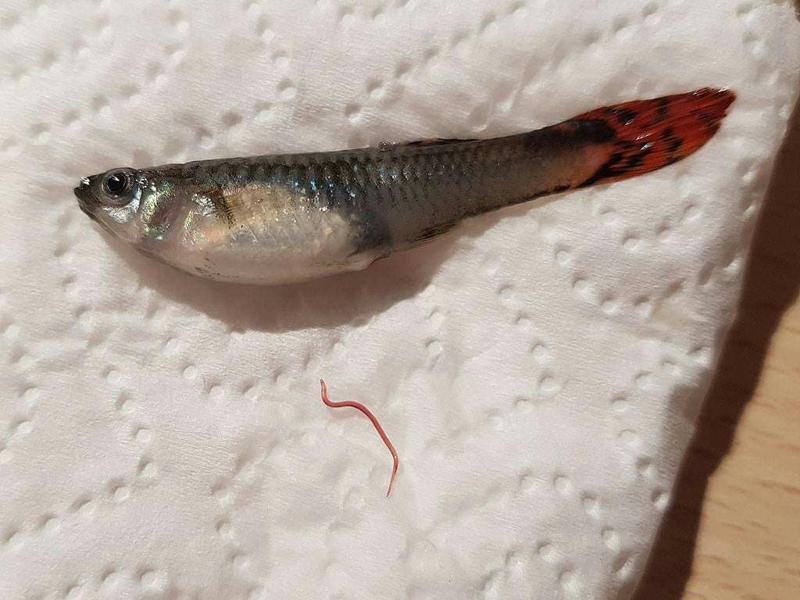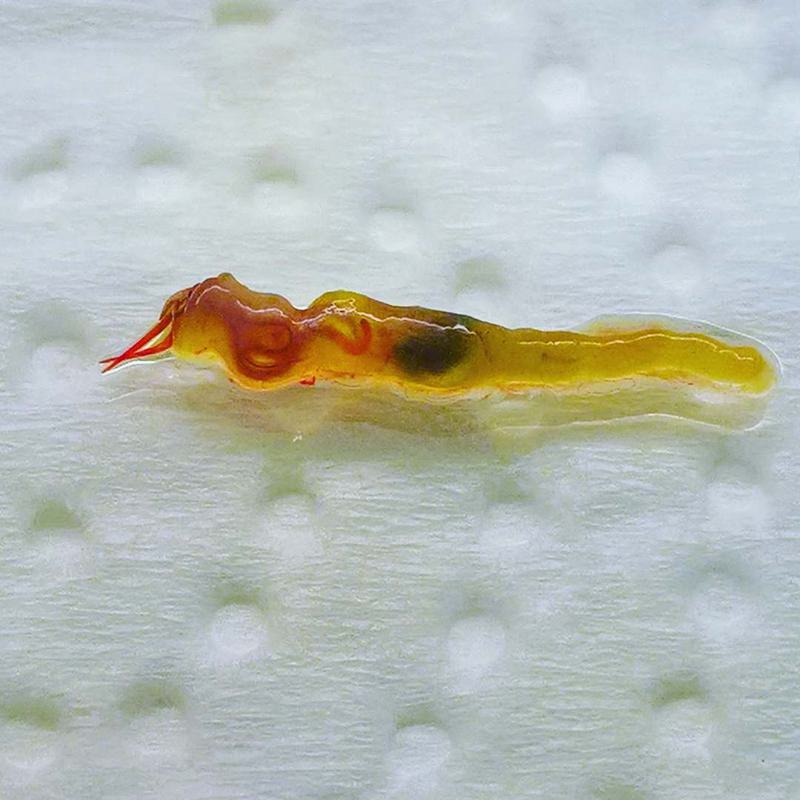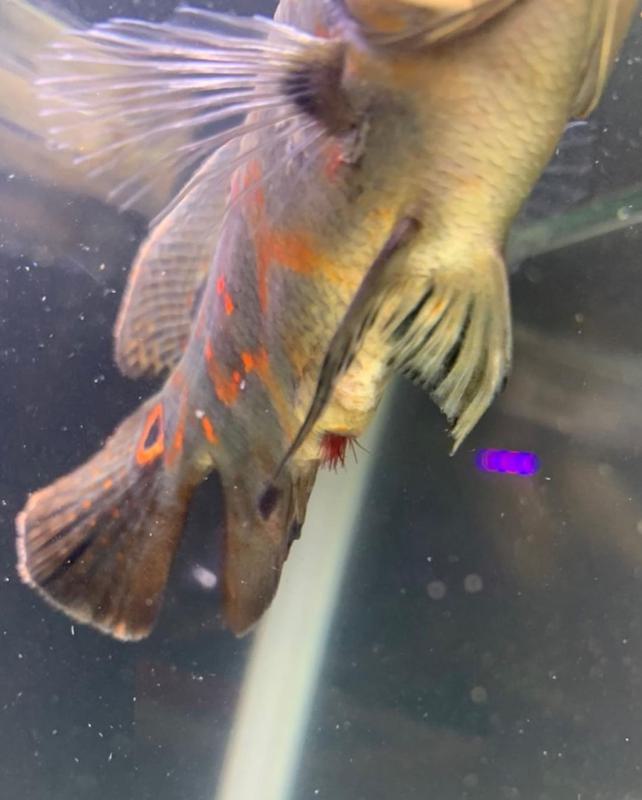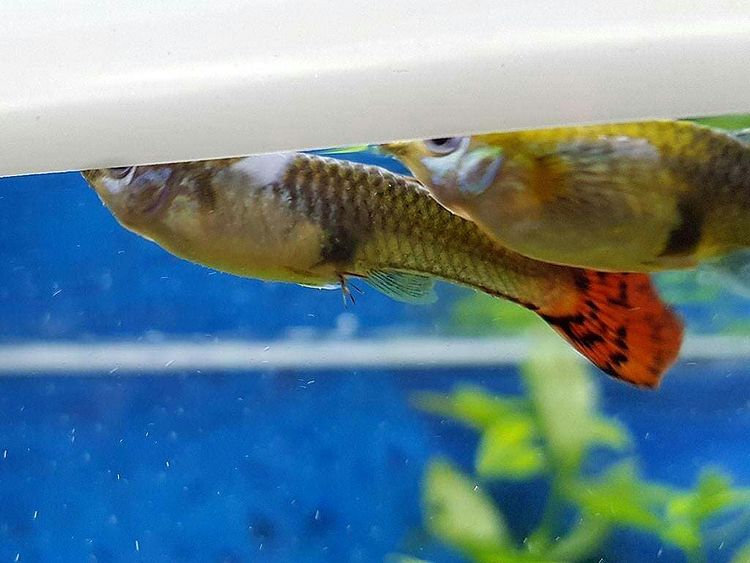Perhaps you’ve one day noticed small red threads emerging from your fish’s anal vent and you’re not sure what to make of the situation.
In this article, we’ll be looking at the cause of these red threads, known as camallanus worms, how fish can become infected, and what actions you can take to resolve the infestation.
Camallanus worms are a type of parasite that is known to infect freshwater fish, such as guppies and bettas.
In severe cases, the worms can be seen as red threads appearing out of the fish’s anal vent, after which they must be treated with anthelminthic medication, or the fish risks dying.
Before going into detail on how to treat and prevent these worms, let’s first understand a bit more about them so you can see why they’re such a threat to your fish.
What are Camallanus Worms?

Camallanus worms are part of the Camallanus genus, which contains many species of nematodes (roundworms) that can infect freshwater fish. These worms are red in color, often known as camallanus red worms.
These worms feed by attaching themselves to the intestinal walls of fish, and can usually co-exist with their hosts for extended periods of time, sometimes without inducing any symptoms.
However, when stress factors (such as bad water quality or tank aggression) are present in the water, the fish’s immune system can be weakened enough that these worms begin rapidly multiplying and eventually cause serious damage or death to the fish.
How Do Camallanus Worms Infect Fish?

Camallanus worms go through a 3 stage life cycle, during which time it infects crustaceans and fish after they’re eaten. Here are the stages in detail:
Stage 1: Mature females, after mating, produce first-stage larvae inside a host fish. These larvae are released after the host fish defecates. These larvae then settle onto the substrate and trick crustaceans into consuming them.
Stage 2: The larvae move into the intermediate host’s (crustacean) gut and molt into their second and inactive third-stage larvae. The larvae sit in the intermediate host until the latter is eaten by a fish.
Stage 3: Once eaten by the fish, the larvae then become active and begin feeding again, eventually molting twice to become sexually mature male or female adult worms.
What are the Symptoms of a Camallanus Worm Infection?

A light camallanus worm infection can often result in no symptoms, however, a serious infection can lead to the presence of red, thread-like worms protruding from the anus of the fish. In this case, the threads can reach up to a few millimeters in length.
Besides the physical appearance of the worm, you may also see signs of discomfort within your fish. Signs to look out for include the fact that the juvenile fish are growing slower, the adult fish may not breed as often, and that you may sometimes see a fish die occasionally throughout a few months.
When the infection has reached a critical level, you’ll not only see worms protruding from the fish but also the fish appearing abnormally thin (due to the worms blocking the intestines and absorbing the nutrients). The fish may also have abdominal bloating due to the worms filling its stomach, resulting in a lack of interest in food for the fish.
Symptoms are typically more noticeable in small livebearers, such as guppies, since it only takes a few worms to cause a serious infection.
Symptoms will also be worse if the host fish is living in unhealthy water conditions, as the negative environment can reduce the fish’s immune response, thus making it easier for the worms to propagate and damage the fish.
What Fish Do Camallanus Worms Infect?

Camallanus worms are some of the most commonly seen internal parasites for aquarium fish and can infect a wide range of fish species, from guppies to goldfish.
Although camallanus worms are often associated with fish such as guppies, mollies, loaches, dwarf cichlid fish, angelfish, and discus, just about all types of aquarium fish can be infected.
Camallanus worms also infect a variety of crustaceans, such as shrimp, as part of the second stage in their life cycle. However, these intermediate hosts do not spread the worms, instead keeping them dormant inside their bodies.
Different species of camallanus worms infect different hosts, however, the ones you’re most likely to see in your fish tank are the east Asian species camallanus cotti.
Besides the fish mentioned above, camallanus cotti also infects gobies, bagrid catfish, and carp in the wild.
Are Camallanus Worms Harmful?
Camallanus worms can be harmful to fish, especially those that are immune compromised due to poor water quality. These worms are known to burrow themselves into the fish’s digestive tract to feed on blood, giving them the nickname vampire worms.
Not only do these worms feed on the blood of your fish, they also block up their intestines, hence preventing fish from getting their essential nutrients all the while the worms are multiplying further. And because these worms damage the insides of fish, they can indirectly lead to bacterial infections and internal bleeding.
All of this is made worse by the fact that the adult worms can multiply to the point where they block off the anal canal of the fish so that the fish can’t pass them. Without treatment, this will inevitably lead to the fish’s quick yet painful death.
How to Treat a Camallanus Worm Infection?
The most effective way of treating a camallanus infection is to use anthelminthic medications. These medications range from fenbendazole to levamisole and praziquantel.
Materials You May Need:
- Anthelminthic medication (the exact type will depend on the fish and what your local pet store recommends)
- Aquarium siphon containing a vacuum
- Freshwater
- Any broad-spectrum antibiotics or antifungal treatments as necessary
- Non-toxic disinfectants
What You’ll Need to Do
Anthelminthic medications mainly paralyze the worms, allowing them to be pushed out of the intestines and the anus by the fish into the aquarium. You’ll know that it’s been effective if you see pink or white worms emerge and detach from the anus of the fish.
Be sure to follow the specific instructions on the medication box so that you’ll know how much of it you’ll need for your specific tank size.
The substrate should be thoroughly cleaned using the aquarium siphon once 24 hours have passed since the initial treatment so that you can remove the worms from the tank. You’ll also need to perform a 25% water change to remove the worms and replace the old water with freshwater.
Typically, three treatments of the medication will be required, each about one week apart from the next. This is so that any remaining worms can be hatched from their eggs before you siphon them away.
It’s best not to put the medication in fish food because the fish can lose their appetites when they’re having a serious infection. Instead, you should always add the medication straight to the water so that not only will the fish absorb it, but it’ll also be uniformly distributed in the water.
Be sure to use any antibiotics or antifungal medication as needed if your fish has developed secondary infections.
In order to increase the speed of recovery for your fish, you should try to keep the fish tank clean and sanitized. Be sure to feed the fish high-quality food to allow them to gain weight and energy so that they can expel the worms quicker.
Also, be sure to keep the water quality high by consistently vacuuming the substrate, disinfecting any equipment used to handle the fish, and performing water changes on a regular basis.
Keep in mind that these medications can be harmful to snails and shrimp, so you should be mindful of removing them before you use the medication. Veterinarian advice is always recommended if you’re unsure about the process.
Read More:
- Common Guppy Diseases: Reasons & Treatments
- Tiny White Worms in Aquarium
- Detritus Worms in Aquarium: What Should I Do?
FAQs
Can Camallanus Worms Infect Humans?
Camallanus worms can’t infect humans as these worms are not known to be transmissible to humans.
These worms can’t do any harm to humans and, even if they could, you’d have to ingest the eggs first, which would be near impossible considering they’re always passed by the fish onto the substrate.
If you are particularly worried, remember that you can always confidently consume fish fillets once they’ve been properly cleaned, prepared, and cooked up to 145 degrees Fahrenheit. This removes any possibility of worms inside the fish surviving.
How Can You Prevent a Camallanus Worm Infection?
To prevent new infections in your current fish, remember to quarantine new fish for a few weeks in order to observe their behavior, appetite, and health so that you don’t risk introducing worms to your tank.
During this time, you can add preventative treatment using anthelminthic medication.
Fish can usually survive with these worms for a time before the infection worsens, so remember to keep the tank sanitized and feed the fish high-quality food to prevent stress levels.
Finally, you should avoid contamination between the old and new fish by keeping the quarantine tank a good distance away from your primary tank.
You should also wash your hands carefully after managing the quarantine tank, as well as separate any equipment you used for the quarantine tank away from the primary one.
Conclusion
Camallanus worms might seem like an unpleasant sight at first, but taking care of the problem is quite straightforward and involves only a few simple steps.
If you wish to keep any of your fish from dying, however, you should take the appropriate preventative measures to make sure your fish don’t have an infection in the first place.